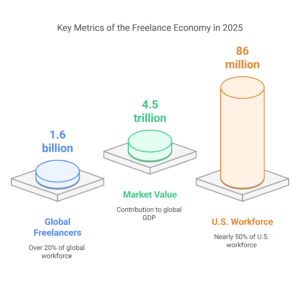Introduction
Freelancing has emerged as a dominant force in the global workforce, reshaping traditional employment structures and driving innovation in how work gets done. By 2025, freelancing will continue its rapid growth, propelled by technological advancements, remote work trends, and the global shift towards a skills-based economy.
This comprehensive article explores the latest freelance market statistics and trends for 2025, offering valuable insights for freelancers, businesses, and policymakers. From the economic impact of freelancing to sector-specific trends, this guide is your ultimate resource for understanding the freelance landscape this year.
The Growth of the Freelance Economy in 2025
The freelancing economy is thriving like never before. According to recent reports:
Global Freelancers: The number of freelancers worldwide is estimated to exceed 1.6 billion in 2025, accounting for more than 20% of the global workforce.
Market Value: The freelance economy is projected to contribute over $4.5 trillion to the global GDP, up from $3.8 trillion in 2022 (Statista).
U.S. Workforce: In the United States alone, freelancers represent nearly 50% of the workforce, with over 86 million Americans participating in freelance work by the end of 2025.
The steady increase in freelance participation highlights a seismic shift in how individuals and businesses approach work. This trend is driven by the flexibility freelancing offers, along with a growing reliance on technology that facilitates seamless collaboration across borders.
Top Freelance Industries in 2025
Freelancing spans virtually every sector, but some industries stand out for their rapid growth and high demand:
Technology & IT:
47% of global freelance earnings come from tech-related jobs, including software development, cybersecurity, and data analysis (Payoneer).
Artificial intelligence (AI) and machine learning are the fastest-growing skills, with demand for freelance AI developers increasing by 32% year-over-year.
Creative Services:
Graphic design, content creation, and video production continue to dominate freelance job boards, with an estimated 25% increase in project volume compared to 2024.
Digital Marketing:
SEO specialists, social media managers, and digital marketers remain in high demand, with businesses allocating up to 45% of their marketing budgets to freelance talent.
Healthcare and Telemedicine:
The rise of telemedicine has opened opportunities for freelance healthcare professionals, including nurses, therapists, and medical coders. Freelance healthcare jobs are expected to grow by 18% in 2025.
Education & E-learning:
With the global e-learning market surpassing $400 billion, demand for freelance educators, instructional designers, and course developers is at an all-time high.
These industries reflect the adaptability of freelancing to meet evolving market needs, offering lucrative opportunities for skilled professionals.
Key Statistics on Freelance Work Platforms
Freelance platforms have become the backbone of the gig economy, connecting talent with opportunities:
Upwork: Reported a 23% increase in client spending in 2025, with freelancers earning over $5 billion collectively through the platform.
Fiverr: Saw a 30% rise in freelance signups, with creative services being the most popular category.
Toptal: Maintains its position as the go-to platform for high-end freelance talent, with an average project value exceeding $10,000.
LinkedIn: Freelancing jobs on LinkedIn grew by 40%, with the platform introducing enhanced tools for freelancers to showcase their portfolios and connect with clients.
These platforms not only facilitate job matching but also foster trust and transparency in the freelance marketplace.
Trends Shaping Freelancing in 2025
Remote Work Normalization:
The COVID-19 pandemic permanently shifted perceptions of remote work. By 2025, 73% of companies have adopted hybrid or fully remote work models, creating more opportunities for freelancers.
Digital Nomadism:
The number of digital nomads has grown to over 50 million worldwide, driven by flexible work policies and the availability of remote-friendly visas in 45+ countries. Popular destinations include Portugal, Bali, and Costa Rica.
AI and Automation:
While some fear automation may replace jobs, it is also creating new opportunities. Freelancers skilled in AI integration, chatbot development, and automation tools are in high demand.
Rise of Specialized Niches:
General freelancing is giving way to specialization. For example:
“No-code developers” experienced a 22% increase in demand in 2025.
Freelance consultants in ESG (Environmental, Social, and Governance) saw earnings grow by 15% year-over-year.
Sustainability in Freelancing:
With environmental concerns taking center stage, freelancers are increasingly focusing on sustainable business practices, such as reducing travel and using eco-friendly tools.
Economic Impact of Freelancing
Freelancing is no longer a side hustle; it is a major economic driver:
Economic Contribution: Freelancers in the U.S. generated over $1.5 trillion in economic activity, up from $1.3 trillion in 2022.
Income Potential: The average hourly rate for skilled freelancers has risen to $28 per hour, with specialized roles earning upwards of $100 per hour.
Additionally, freelancing has empowered individuals in developing countries to access global markets. Platforms like Fiverr and Upwork report significant growth in earnings among freelancers in regions like Southeast Asia, Latin America, and Africa.
Challenges Facing Freelancers in 2025
Despite its benefits, freelancing is not without challenges:
Income Instability:
While freelance opportunities are abundant, income can be unpredictable. Surveys show that 63% of freelancers worry about inconsistent earnings.
Competition:
The freelance talent pool is growing, with a 19% increase in new freelancers joining the market in 2025. Standing out requires strong branding and specialization.
Burnout:
Managing multiple projects and clients can lead to overwork, with 41% of freelancers reporting burnout as a significant concern.
Regulatory Issues:
Governments worldwide are introducing stricter regulations on gig work. For instance, the EU’s Platform Work Directive aims to reclassify certain freelancers as employees, impacting their flexibility.
These challenges highlight the importance of strategic planning and adaptability for long-term freelance success.
The Future of Freelancing
As freelancing continues to evolve, several predictions stand out for 2025 and beyond:
AI-Powered Platforms: Freelance platforms will increasingly use AI to match clients with talent, making job searches faster and more accurate.
Blockchain Payments: Cryptocurrency and blockchain technology are gaining traction, offering faster, low-cost payment solutions for freelancers working globally.
Freelance Unions: With growing concerns over benefits and worker rights, freelance unions are becoming more prominent, advocating for better protections and resources.
Freelancing is expected to expand further into sectors like biotechnology, space exploration, and green energy, reflecting its adaptability to emerging industries.
Conclusion
The freelance market in 2025 is a dynamic and thriving ecosystem, driven by technology, changing workforce preferences, and global connectivity. With over 1.6 billion freelancers worldwide and a market value exceeding $4.5 trillion, freelancing is reshaping the future of work.
For individuals considering freelancing, the opportunities are immense, but success requires staying ahead of trends, continuously honing skills, and navigating challenges effectively. As the gig economy continues to evolve, one thing is certain: freelancing is not just the future of work, it’s the present.


